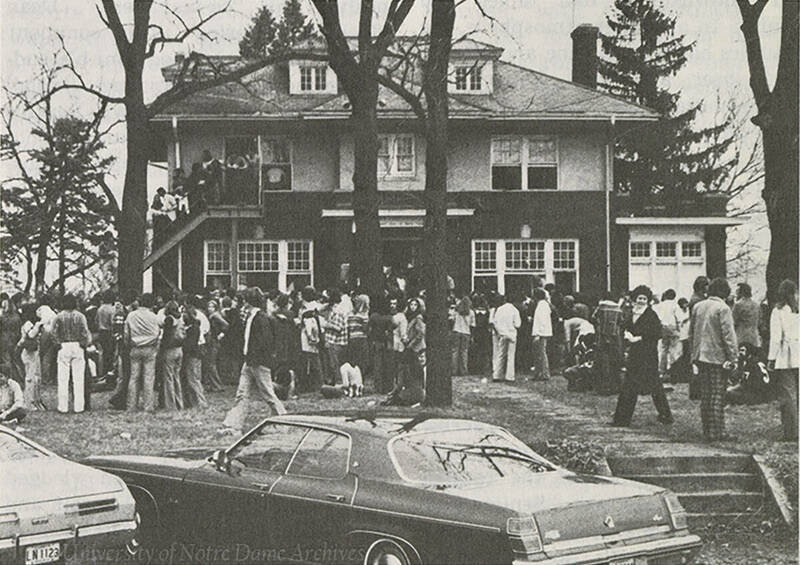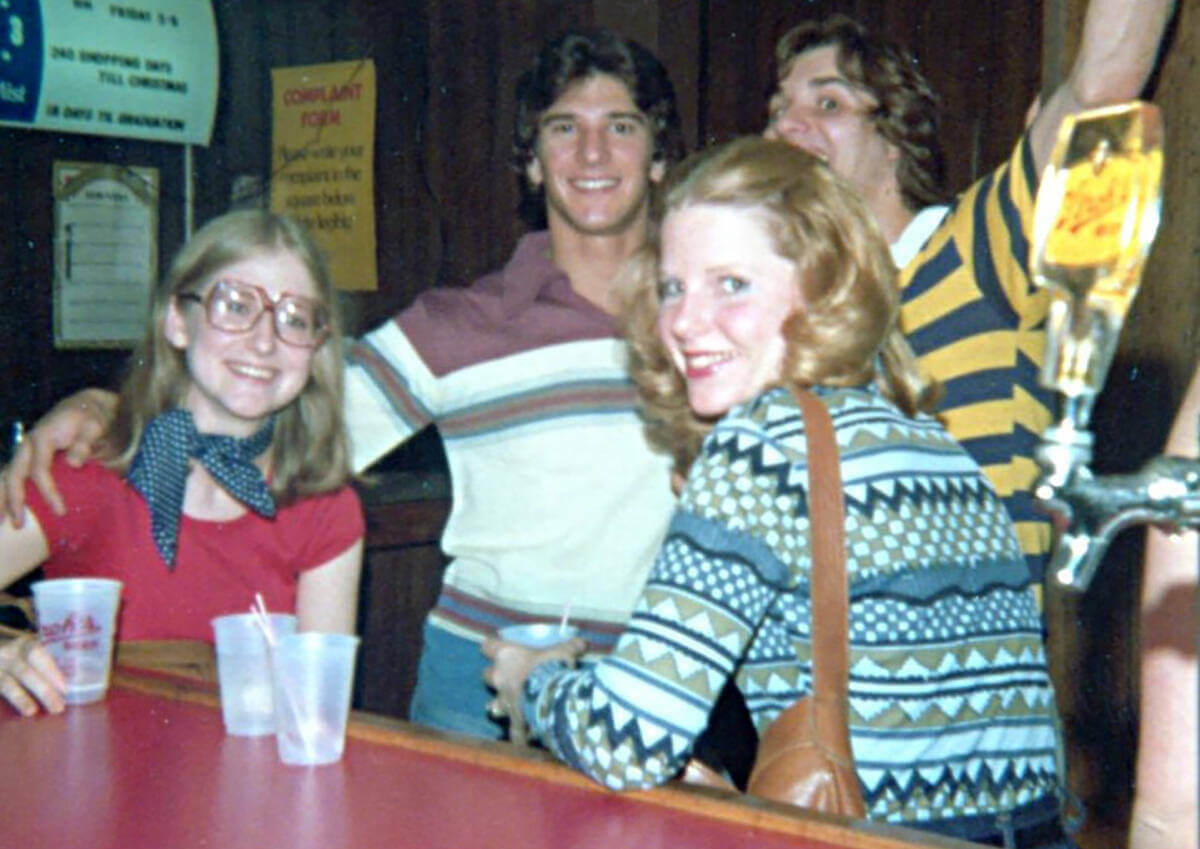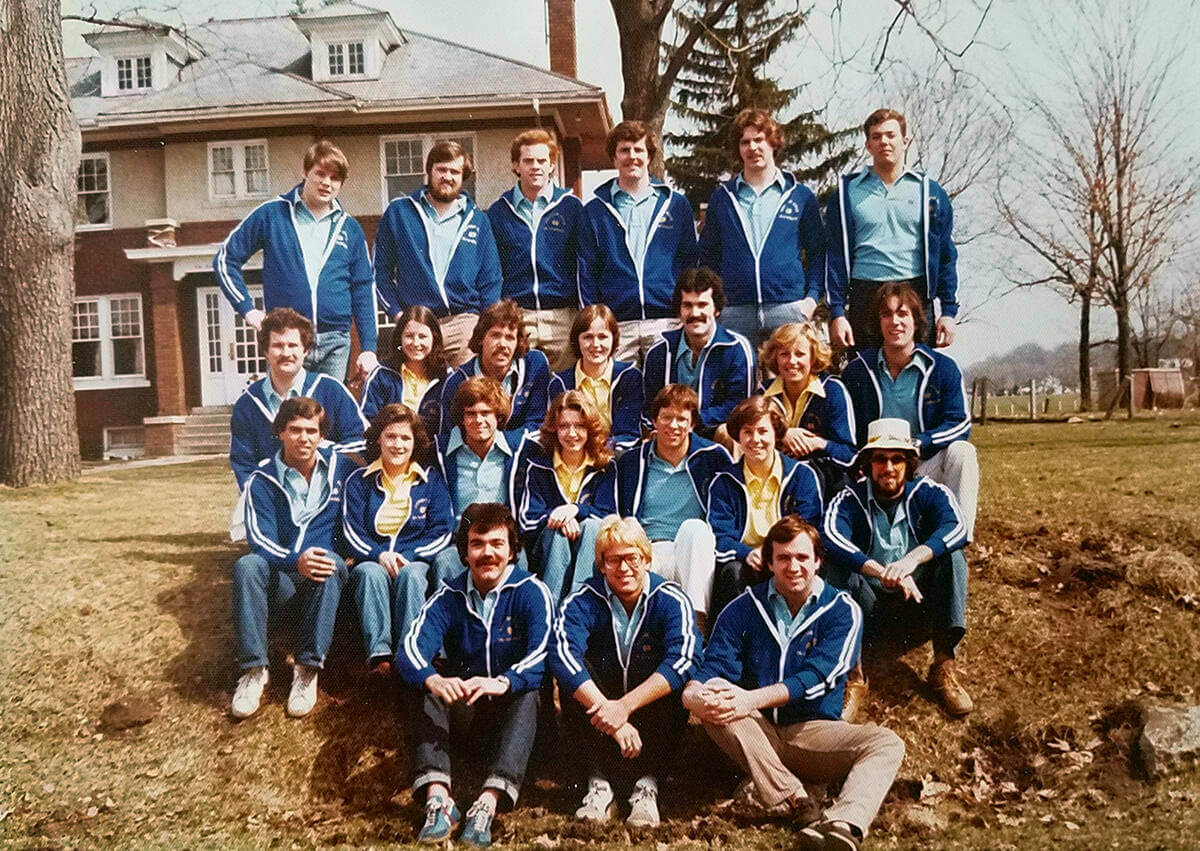 Scholastic magazine captured students partying outside Senior Bar in 1975. University of Notre Dame Archives
Scholastic magazine captured students partying outside Senior Bar in 1975. University of Notre Dame Archives
The old brick house south of Notre Dame Stadium is long gone. But for a generation of Notre Dame alumni, it still conjures magical memories.
The two-story building was formally known as the Alumni-Senior Club. For undergraduates between 1969 and 1982, it was the Senior Bar — a student-run campus gathering spot for those 21 and older.
“It was an old rickety house with a lot of charm. It was a special place,” says Tim Thompson ’82, the last student general manager of Senior Bar at its old location.
It was run by student managers, who applied and were interviewed by administrators. The student managers hired the bartenders, the bouncers who carded patrons at the door, and other student workers.
“It was one of the greatest jobs in the world,” recalls Ed Weinlein ’69, who worked on the Senior Bar staff the last semester of his senior year, just before he shipped out to serve in the U.S. Navy in the Vietnam War.
Weinlein says he didn’t take the job for the money, but for the fun and the atmosphere. “We would have been there anyway. That’s where your social life was,” he says. “At times it was really crowded, with lines out the door.”
The decor was minimalist: a couple of bars, a pool table and a jukebox. A few years later, a dance floor was created on the second floor, a DJ spun records and some coin-operated game machines were added. There was never a full kitchen, although the place offered pretzels and other snacks, and some years sold pizza or sandwiches.
The original Alumni-Senior Club started out as a family home. In March 1916, Notre Dame sold 10 acres of land south of Cartier Field to Daniel J. McNamara, a Catholic life insurance executive who lived in South Bend with his wife, Caroline, and their four children. A contractor was hired and construction began on the brick residence.
McNamara, age 57, died suddenly that July during an intense heat wave that claimed at least eight lives locally, the South Bend Tribune reported. His grave is in Cedar Grove Cemetery.
Caroline McNamara continued with construction and moved into the house with her children: Mary, William, Daniel J. Jr., and John. The family lived there until about 1928, then sold the house and the land back to the University.

During their childhood on campus, Daniel and John both attended Notre Dame’s grade school program as minims, and William attended the campus high school program. All three later took college-level classes, with John earning a degree in 1933. Mary attended Saint Mary’s College and married Ivan C. Sharp, a 1923 Notre Dame graduate.
The house stood essentially on farmland in those days, fronting on a rural stretch of Eddy Street. Photos of Notre Dame Stadium under construction in 1929-30 show the old McNamara house in the distance, surrounded by grassy fields.
During the 1930s and 1940s, the house served as a residence for various students and employees. The last resident during that era was Elvin “Doc” Handy, a Notre Dame track coach.
In 1951, the University renovated the building and renamed it André House, in honor of Brother André Bessette, CSC, (who was canonized in 2010.) André House was home to postulates undergoing religious training to become Brothers of the Holy Cross and a few Holy Cross seminarians. The south sun parlor was converted into a chapel. In 1957, André House became a residence for Brothers of the Christian Schools studying for graduate degrees at Notre Dame.
By 1963, the building was a faculty clubhouse. It was no longer needed when the University Club (since demolished) opened in 1968, so the old McNamara place sat vacant.
In the 1960s, Notre Dame students established several unofficial “senior bars” off campus, including at the Flamingo and Club Nicola — taverns on North Hill Street near downtown South Bend. Student organizers sold club cards for about $10 that students were required to show to enter the senior-only gathering spots.
There were safety concerns around the two nightclubs and about students walking back to campus late at night. Seniors approached the University administration and asked about the old McNamara house. An agreement was forged and the Alumni-Senior Club opened in January 1969.
As patrons entered the front door, there was a large bar to the left. A staircase in the central foyer led to the second-story dance floor and another bar. The club operated Wednesday through Saturday. In 1970, a glass of cold Schlitz on tap sold for 30 cents.
For the first few years, the club was a partnership, with the Notre Dame Alumni Association the official holder of the liquor license. On football Saturdays, alumni would turn out at the club before and after games. The rest of the year, it was entirely a student hangout.
The club operated rent free, but the bar income had to cover all the salaries, maintenance and improvements. A few upgrades were made, including a fire escape added in 1975. There were happy hours and theme nights. On “Rejection Letter Night,” a senior could buy a beer for one cent by presenting a rejection letter from a job recruiter.

Mary Reiner Shutters ’77 worked there as a bartender during her senior year. She and most of the other workers served only beer. There was little demand for mixed drinks in that era and only one employee knew how to make them, she says. No one drank wine.
There was a TV in the main bar room. Student customers turned out on Wednesday nights to gather and watch Charlie’s Angels, a popular new TV show, she says.
“On weekends I recall there was often music playing in the background. I remember Boz Skaggs (songs: “Lido Shuffle,” “Lowdown”) and Fleetwood Mac (“Dreams,” “Go Your Own Way”),” Reiner Shutters says. “I still think of the Senior Bar when I hear those songs!”
Thompson, the 1982 graduate who was the last general manager of old Senior Bar, reported to Dean of Students James A. Roemer ’51, ’55J.D. It was a cordial relationship. “He gave us a lot of latitude, as things were well run,” Thompson says. “We were making money.”
He shared responsibility with three other managers and oversaw a part-time staff of more than 30 student employees. He remains close friends with some of those former coworkers today.
“Before senior year, we made friends in our dorms and classes. Senior Bar was the one place every (senior) could congregate from across campus,” he says. “It allowed me to get to know a lot of people and forge new friendships.”
The original Alumni-Senior Club’s run ended in spring 1982, when it closed its doors for the last time. It was demolished that summer, and a new, larger, one-story Alumni-Senior Club (now Legends of Notre Dame restaurant) opened next door.
Today Legends’ fenced patio exists where the old McNamara place stood for more than 60 years. Some of the old oak trees that surrounded the house still stand.
In the 1970s and early 1980s, various local watering holes attracted students, but on Thursday nights, Senior Bar was the place to be.
Liz O’Hara Veon ’82 headed to Senior Bar with a friend at 10 p.m. each Thursday during her senior year. “By 11, it was packed on both the first and second floors,” she recalls. “We would love to start out by having beers at the main bar on the first floor and then move upstairs to where the dance floor, aglow with disco lights, was alive with young people dancing to ‘Shout.’”
On Fridays during football season, lots of alumni would show up, making it hard to move around inside, she says. On football Saturdays, the crowd turned out dressed in ND gear, filled the yard outside and overflowed into nearby Green Field. The smell of hamburgers, hotdogs and beer filled the autumn air, she recalls.
“My Notre Dame years were among the very happiest of my life,” she says. “I am 63 now and I look back at Senior Bar as having been the setting of many of those fantastic memories.”
Margaret Fosmoe is an associate editor of this magazine. Contact her at mfosmoe@nd.edu or @mfosmoe